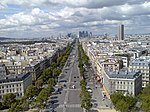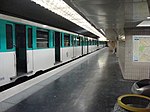Embassy of Ireland, Paris
Buildings and structures completed in 1892Buildings and structures in the 16th arrondissement of ParisDiplomatic missions in ParisDiplomatic missions of the Republic of IrelandFrance–Ireland relations ... and 1 more
Ireland stubs

The Embassy of Ireland in Paris (French: Ambassade d'Irlande à Paris) is the diplomatic mission of Ireland to France. It is located at 12 Avenue Foch in the 16th arrondissement.The embassy is also represented in France by Honorary Consuls in Cherbourg, Antibes/Cannes,Toulouse and Lyon. The embassy is accredited to Monaco, where it also has an honorary consul. As of January 2019, the current Ambassador to France is Patricia O'Brien, previously the Irish Ambassador to the United Nations and Other International Organisations, Geneva.
Excerpt from the Wikipedia article Embassy of Ireland, Paris (License: CC BY-SA 3.0, Authors, Images).Embassy of Ireland, Paris
Rue de Saïgon, Paris 16th Arrondissement (Paris)
Geographical coordinates (GPS) Address Website External links Nearby Places Show on map
Geographical coordinates (GPS)
| Latitude | Longitude |
|---|---|
| N 48.8740752 ° | E 2.2914557 ° |
Address
Ambassade d'Irlande
Rue de Saïgon
75116 Paris, 16th Arrondissement (Paris)
Ile-de-France, France
Open on Google Maps











